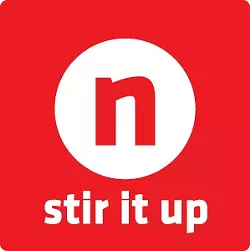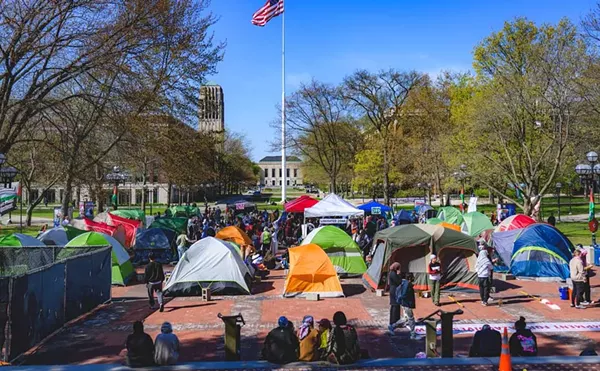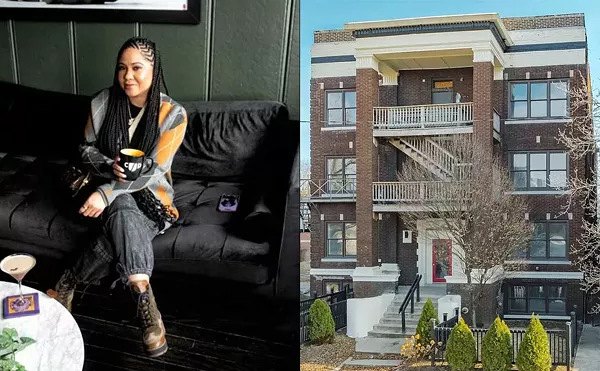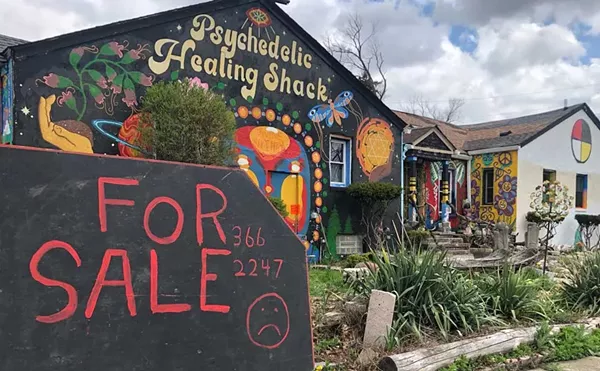
Audio By Carbonatix
[
{
"name": "GPT - Leaderboard - Inline - Content",
"component": "35519556",
"insertPoint": "5th",
"startingPoint": "3",
"requiredCountToDisplay": "3",
"maxInsertions": 100,
"adList": [
{
"adPreset": "LeaderboardInline"
}
]
}
]

Hyde Park is a tidy little space in the Greenacres neighborhood. It is teardrop shaped and about a half-block long. There’s a gazebo, a couple of picnic tables and benches there, some flower beds and a little hill where I tried to teach my daughter how to ride a bicycle some years back. The neighborhood association hosts several events there each year, including Kids and Family Day, an annual jazz concert, and a pumpkin sale at Halloween. There are other neighborhood events that use the park as a staging ground, such as neighborhood cleanups and the Jane’s Walk that had its inaugural last year and is being planned again this year.
It’s small, clean and fits nicely into the neighborhood. However, it doesn’t have a playscape for the kids. There’s a sign there alerting folks that no ball playing or dogs are allowed. That prompted my daughter to pout and exclaim, “Then what good is it?” years ago when she wanted to take our dog over there to play. Hyde Park is more of a place for grown-ups than for kids. You might find young parents taking a break there during a walk with the kids. But as the kids get older the park doesn’t offer them much. The neighborhood patrol keeps a close eye on it in the evenings to deter teenagers from gathering there after curfew.
Regardless of the lack of recreation for kids there, the neighborhood truly takes ownership of the park. The gazebo was built with funding from a grant written by neighborhood members. The flower beds were planted and are maintained by people in the neighborhood. Neighbors stretch their garden hoses across the street to water the flowers. When the trash receptacles fill up, neighbors will take the trash and put it in their own containers because the city may not get there regularly to empty them. Amazingly enough, the residential trash does get picked up every week. The grass in Hyde Park stays trimmed. If the city doesn’t do it, the nearby New Prospect Missionary Baptist Church and the neighborhood association have a partnership to take care of it.
Maria Dickerson, president of the Greenacres Woodward Civic Association (GWCA), says that a few years ago, when the city was considering closing down 77 parks (including Palmer Park and Rouge Park), Mayor Bing wanted to have a press conference there but decided not to when a staff person came out and looked at the setting. “They changed the location,” says Dickerson. “It wasn’t messed up enough for the press conference. It was too nice.”
Hyde Park is now on the list of 50 parks that the mayor wants to close in the wake of City Council deciding not to vote on the proposed 30-year lease of Belle Isle to the state. When council demurred, citing unanswered questions, the state took the deal off the table. (Though I’ve heard some talk that Belle Isle is in the state budget for next year in anticipation of an emergency manager taking over the city and making the deal with the state.)
Unless the city comes out and puts a fence around the place (something somebody at the Department of Parks and Recreation told me wasn’t likely due to the cost) I can’t imagine things being very different at Hyde Park. “We in the community have been doing the beautification stuff,” Dickerson says. “If they say they can’t cut the grass, we’ll take it over. We’ll just cut our own grass.”
That leads me to think there’s a bit of smoke and mirrors in this parks closings business. Not that I expect anything like the last-minute budget deal that kept the parks open last time around, but I’m wondering if the mayor is trying to put some neighborhood-based heat on City Council. How much money will the city save and how big a deal are many of these parks?
Unless the city somehow secures the parks, I’m guessing it still has to maintain some type of liability insurance in case someone were to go into a park and get injured. I left a message at the city General Services Department, but no one got back to me by deadline. That’s the office that might have told me about fences and insurance issues.
I started looking at other parks that are slated for shutdown. Which I guess means the city won’t mow grass, pick up trash or try to deter rodents in those areas.
Sherwood Park is about a block south of Hyde Park in Sherwood Forest. They are similarly shaped, with the pointy end of their teardrops pointing at each other. Sherwood Park is about half the size of Hyde Park. I’ve always thought of it as more of an island between the streets than a park. There is nothing there but some trees, grass and a sign like ours informing folks not to play ball, drink alcohol, walk dogs or park on the grass. In the 17 years I’ve lived over here, I’ve never seen anything go on in that “park.” I may have seen someone walking a dog there; I’m not sure.
Another nearby one on the list is St. Martins Park, tucked into an area that suggests a cul-de-sac at Roselawn and St. Martin. Its size is more impressive — a rectangle a little longer than a block and a block wide. There’s nothing there but overgrown grass and trees. Not a bench. Not a playscape. Not a grill. Not a table.
I spoke to a woman who lives across the street from there. She said there used to be some structures for kids to play on but they were taken away. A local church has an annual picnic there, and occasionally a family will bring their own grill and chairs to do the same. She says nobody plays ball in there, although some folks in the neighborhood take walks around it.
If St. Martins Park were to be abandoned, it would quickly turn into a small woods that might be picturesque but probably not very safe. Housing in the area looks pretty solid. There’s no outrageous blight, but to let this place go would create problems in what looks like a stable neighborhood just off Outer Drive.
That may well be the case around many parks that are slated to close. Romanowski Park on the southwest side, across from Holmes Elementary School, is slated for closing, although Greening of Detroit runs a small farm there as a tool to teach people agricultural skills. I don’t know if the park closing would shut down the farm, but it looks like folks in the neighborhood there have some buy-in. Neighborhood residents were part of the process of creating the farm and clearing out old rusted playground equipment. I’m sure they consider the park as their place.
There are conservancy and “friends” groups looking out for Belle Isle, Palmer Park and Rouge Park. In the cases of Hyde and Romanowski Parks, there are neighborhood groups taking responsibility for them. There is probably more of that sort of thing happening in some of the other parks. Maybe it would be a good idea if Bing encouraged more farming in parks such as Romanowski. That’s what Detroit Mayor Hazen Pingree did in 1893 when there was a national recession taking place. He encouraged residents to farm in parks and other city-owned land, including the City Hall lawn. Although his program was at first ridiculed, it was later copied in other U.S. cities.
There is already plenty of empty land out there, and there will be even more if the mayor’s blight eradication program increases the demolition of old houses. I don’t think we need to turn all the parks over to farming. But I do think a lot of Detroiters are willing to maintain the small parks inside their neighborhoods. The GWCA’s Dickerson says she’s been hearing from other neighborhood groups who want to know how Greenacres does it with Hyde Park.
As the mayor and City Council bicker with each other and with the governor, folks in the neighborhoods are doing what they have to do to survive. If people come together to keep their local parks clean, they just might come together to do other things to help turn this city around.
Larry Gabriel is a writer, musician and former Metro Times editor. Contact him at letters@metrotimes.com.






